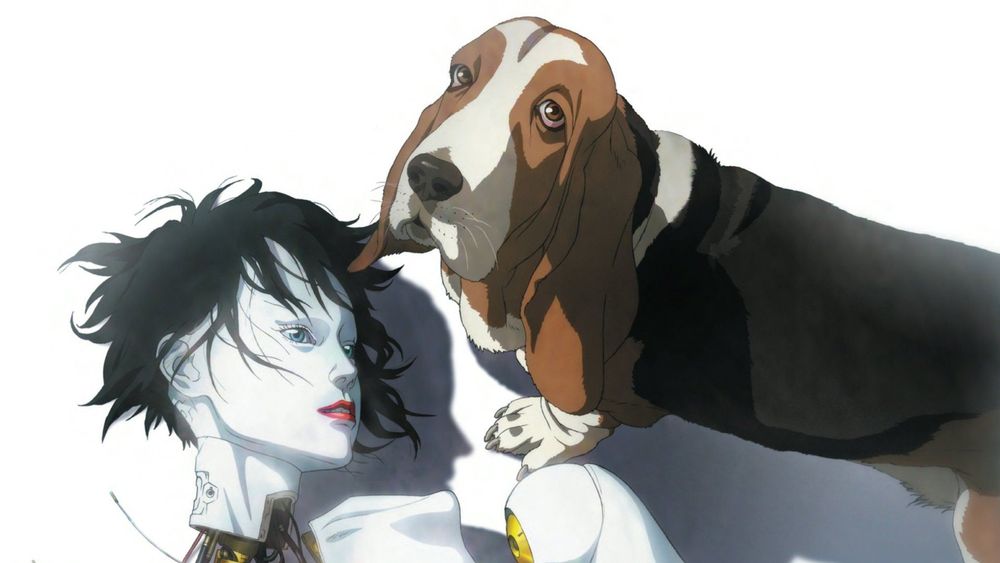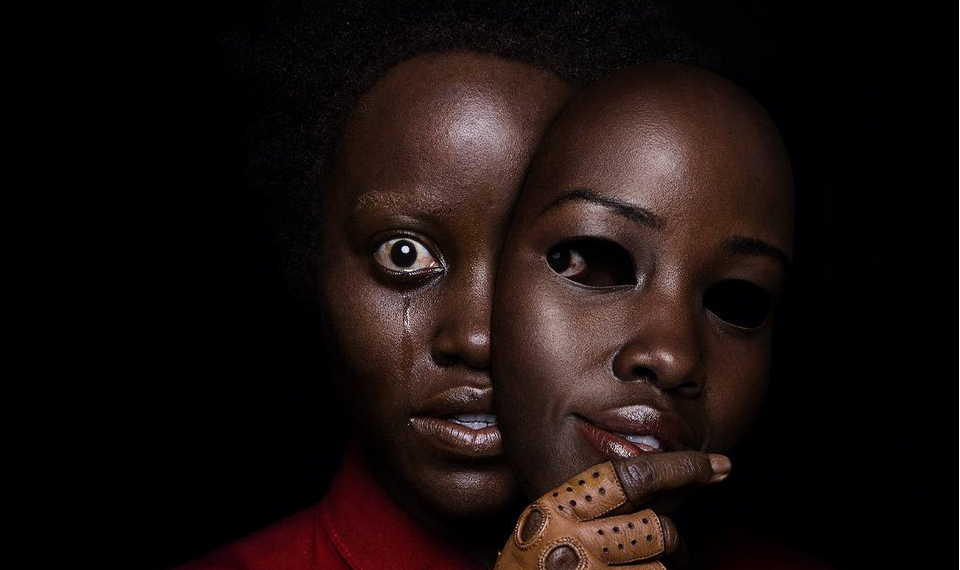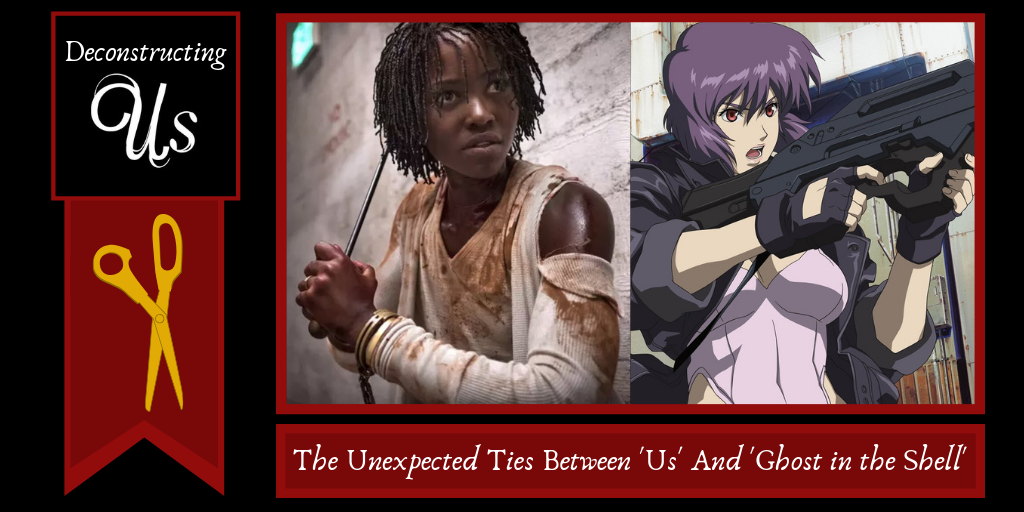Deconstructing Us is a series that will analyze Jordan Peele’s latest film Us. If you have an element you want tackled, email monique@colorwebmag.com or tweet @moniqueblognet.
Us has had me feeling a type of way for about a week now. There’s so much packed into this film that it’s going to take more than one article dissecting it. So here’s what I’m going to do–I’m going to take as many elements from the film and take deeper dives into what the Easter eggs mean to pop culture, politics, and society at large. Sounds daunting, but it’s going to be fun.
To ease into things, I figure I should talk about a tie I don’t anyone has seen. Blame my anime-loving side, but I realized that Us has a lot in common with Ghost in the Shell.
I first became aware of the connection when I listened to the theme from the Us soundtrack, “Anthem.” People have said a lot about this piece of music–several YouTube comments have addressed how the piece’s name could reference either “Us And Them” or “U.S. Anthem,” both inferences offering new, creepy layers. But what I initially noticed is how “Anthem” has tons of overlap with Ghost in the Shell 2: Innocence’s “Ballade of Puppets,” composed by Kenji Kawai.

First, there’s the tonal similarities. The centerpieces of each song is a series of chants. “Ballade of Puppets” uses traditional Japanese Min’yō singers.
Min’yō is a type of traditional Japanese folk music. The type of kuboshi, or form of vibrato, Min’yō employs can make the songs sound haunting and ethereal in my opinion. Coupled Kawai’s composition, “Ballade of Puppets” is one of the most intense and beautiful songs I’ve heard.
Meanwhile, “Anthem” by Michael Abels doesn’t use
Min’yō singers to create a haunting sound for Us. Instead, according to Billboard, Abels employed “a 30-person choir, a third of them children.”
“One thing Jordan loves to do and is becoming known for is [to] take something you always assumed was safe or innocent and turn it into something else,” Abels said to Slate. “The children’s voices is one example–Jordan wanted to start with them because he thought it would be super scary.”
He also used “included Japanese taiko drums, chime-like echoes, anxious violins and restless chorales,” according to Billboard. The latter of which we hear at the forefront of “Anthem,” but it’s the drums, the syncopation, that drives the piece further.
“There’s an important line in Us where Red says, ‘We’re Americans.’ ‘Anthem’ starts out sounding like the march of a Western cultural background, but then a beat drops in–it’s syncopated and funky,” Abels told Slate. “It’s not an Afro-Cuban beat exactly, but it really makes you want to move. ‘Anthem’ is really the march of a multicultural group, like we Americans are.”
While the children’s voices make the song sound immediately scary, it’s that groove that makes the piece really stick in terms of spookiness. It draws you to listen to it repeatedly, which only increases the feelings of uneasiness.
I can’t tell what type of taiko drums are in “Anthem”–But regardless, the fact that taiko drums, traditional Japanese instruments, are used in the Us soundtrack tie back to Ghost in the Shell in how traditional instruments are often used in Kawai’s soundtracks to illustrate the push and pull between modern culture and a hidden culture that’s demanding to be heard.
For Ghost in the Shell, that hidden culture is Japan itself. As I referenced in my Ghost in the Shell Nerds of Color article, Japan has been in a tug of war with itself ever since it suffered the two nuclear bombs at the end of World War II. In an effort to rebuild itself and its self-esteem, Japan threw its weight into technological advancement. But this obsession with technology, this false idol, if you will, has put Japan’s obsession with tech at odds with its former dominant culture–the traditional ways pre-World War II.
A great example of Ghost in the Shell’s examination of the push-and-pull between a technologically savvy-yet disposable culture and a traditional, yet dwindling culture can be seen in this clip from Ghost in the Shell 2: Innocence, in which a traditional procession takes place in a technologically advanced, yet old-world style street. However, the procession is made up of automaton dolls, which also have a place in Japan’s past (as stated in Yoshiko Okuyama’s Japanese Mythology in Film: A Semiotic Approach to Reading Japanese Film and Anime, the Edo period was fascinated with dolls, or ningyō, that were automatic). The music throughout Ghost in the Shell 2: Innocence is sung in the min’yō or “folk song” style, evoking more of old Japan coming into conflict with the Japan built from the ashes. Even the dolls burned in the scene evoke a feeling of disposability, harkening back to the disposability of our lead heroine’s own body.
“[A]fter asking whether you think [the robot “shells” are] a necessary element, you’re left asking by the end of the film what exactly are the uses of a human body which has no unique identity of its own,” states Emad Ahmed for The New Statesman. Anyone can argue that a Ghost in the Shell movie starring anyone could make the same argument, but the cultural nuance that was imbued in the media by that statement—the anxiety Japan faces as it takes on a new “shell” to forego the past—is something important that Hollywood shouldn’t have left on the cutting floor.
Jon Tsuei is Right: A #WhitewashedOUT Ghost in the Shell Misses the Cultural Mark
Ghost in the Shell‘s themes of disposability are intrinsic in the “shells” people wear, like Major Kusanagi’s technologically-advanced body. Similar to Us, Kusangi is like the Tethered; she’s a humanoid to the eyes, but her soul is something that’s almost negotiable. While we are led to believe her soul is still intact because of her brain’s existence, others might argue she doesn’t have a soul at all–all she has are memories that form a facsimile of a soul.
The Tethered, on the other hand, are considered “shells” of humanity. They are thought to be animalistic experiments gone wrong when government scientists tried to recreate humans from the soul up. But that’s only because the Tethered have been forgotten by the scientists who abandoned them. In turn, they’ve been forgotten by society at large, leading their humanity to become negated.
But both the Tethered and the “shells” rise up in their own ways to be recognized as human. Even though there’s fear and confusion working against them, they still strive for the rights of humanity by any means necessary.

A particularly haunting line from “Ballade of Puppets” reflects this anger-fueled fight for recognition:
The blossoms beseech the gods.
Ghost in the Shell Wikia
“Even though in this world we may know grief and suffering”
“Our dreams shall never die”
“Even though in this world we may know grief and suffering”
“Our dreams shall never die,” and they fall from the branch in anger
Both the Tethered and the shells are battling the old ways, even though the battles are a little different. Even though both beings were created without thought to what could be unleashed, the cyborgs in Ghost in the Shell face a more existential look at life. Their struggles are as internal as they are external; the battle for the soul is very much within the minds of the shells themselves. Meanwhile, the Tethered fight for respect with blunt violence. Their reasons for fighting are understandable, but their methods are reprehensible and only replicate the violence their oppressors used on them. You could say the different strategies fall along cultural lines; while Ghost in the Shell shows Japan’s homogeneous identity being threatened by their own creations, Us analyzes how America continues breathing life into its original sin of using violence as a vehicle for freedom.
We’ve only scratched the surface of what Us reveals about ourselves and our society. Hopefully this first post gave you some food for thought. Let’s see what else we uncover together!
